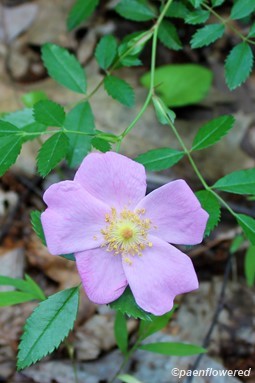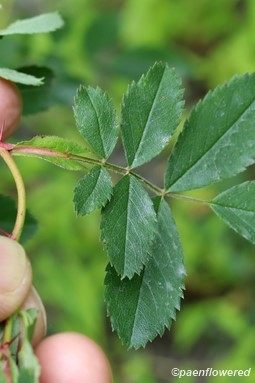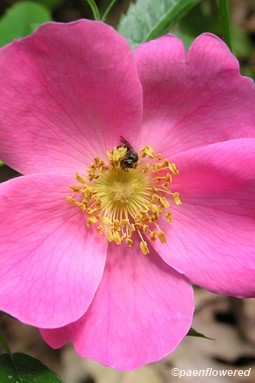Rosa carolina
Rosa carolina pasture rose
The several species of local wild roses can be difficult to tell apart. This wild native species of rose is similar to the swamp rose, but the bush is low and slender. The thorns or prickles are straight rather than curved like those of swamp rose and other local species. These sharp thorns are found just below the stipules where the leaves attach to the branch. They often occur in pairs.
The flowers are light pink and large—up to 2 inches in diameter. The pistil structure tends to be wide and flat, unlike the tall and narrow column-shaped pistil structure of other wild roses. They have a strong and pleasant fragrance. The bush grows to a height of 1-3 feet and is found in dry soil, rocky fields, in thickets, along roadsides and in openings in wooded areas. It is also common along railroad tracks. It is found throughout much of the eastern half of North America south of Ontario.
The Carolina rose, like other wild roses has pinnately compound leaves. Normally there are 5-7 leaflets but sometimes fewer. Each ovate leaflet is about 2 inches long. The Carolina rose blooms in June and July. The Virginia, prairie or wild rose (Rosa virginiana) has a similar appearance but has curved thorns and glandular hairs on the round fruit, stems and on the lobed sepals. Confusion can be created because these two species often share the same common names.
Habitat & Range
Frequently found in dry, open grounds.
Present throughout the state.
| EMP: | FACU |
|---|---|
| NCNE: | FACU |
Phenology
Flowers May to July.
Plant Codes
S-rank: No Rank
G-rank: G5 (Secure)







Comments
Have you spotted this plant in your area? We'd love to hear about your experience! Share your comments or questions about the plant below. Comments are moderated before posting.